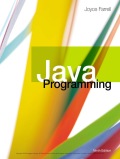
a.
Explanation of Solution
Program:
File name: “RetirementGoal.java”
//Import necessary header files
import java.util.Scanner;
//Define a class named RetirementGoal
public class RetirementGoal
{
//Define main method
public static void main (String[] args)
{
//Create an object for the Scanner class
Scanner input = new Scanner(System.in);
//Declare the variables
int years;
int saveAmount;
int total;
/*Prompt the user to enter the number of years the user
has until retirement */
System.out.print("How many years until retirement? >> ");
years = input.nextInt();
/*While condition if the user enters 0 or a negative number*/
while(years <= 0)
{
//Print the error message
System.out.println("Years cannot be 0 or negative");
//Reprompt the user to make a valid entry
System...
b.
Explanation of Solution
Program:
File name: “RetirementGoal2.java”
//Import necessary header files
import java.util.Scanner;
//Define a class named RetirementGoal2
public class RetirementGoal2
{
//Define main method
public static void main (String[] args)
{
//Create an object for the Scanner class
Scanner input = new Scanner(System.in);
//Declare the variables
int years;
int saveAmount;
int total;
final double RATE = 0.04;
/*Prompt the user to enter the number of years the user
has until retirement */
System.out.print("How many years until retirement? >> ");
years = input.nextInt();
/*While condition if the user enters 0 or a negative number*/
while(years <= 0)
{
//Print the error message
System.out.println("Years cannot be 0 or negative");
//Reprompt the user to make a valid entry
System.out.print("Please renter years >> ");
years = input.nextInt();
}
/*Prompt the user to enter the amount of money the user can save annually*/
System.out.print("How much can you save annually? >> ");
saveAmount = input.nextInt();
/*While condition if the user enters 0 or a negative number*/
while(saveAmount <= 0)
{
//Print the error message
System...
Trending nowThis is a popular solution!

- Draw an ERD that represents a book in a library system. Be sure to add relationship types, key attributes, attributes and multiplicity on the ERD.arrow_forward2:21 m Ο 21% AlmaNet WE ARE HIRING Experienced Freshers Salesforce Platform Developer APPLY NOW SEND YOUR CV: Email: hr.almanet@gmail.com Contact: +91 6264643660 Visit: www.almanet.in Locations: India, USA, UK, Vietnam (Remote & Hybrid Options Available)arrow_forwardProvide a detailed explanation of the architecture on the diagramarrow_forward
- hello please explain the architecture in the diagram below. thanks youarrow_forwardComplete the JavaScript function addPixels () to calculate the sum of pixelAmount and the given element's cssProperty value, and return the new "px" value. Ex: If helloElem's width is 150px, then calling addPixels (hello Elem, "width", 50) should return 150px + 50px = "200px". SHOW EXPECTED HTML JavaScript 1 function addPixels (element, cssProperty, pixelAmount) { 2 3 /* Your solution goes here *1 4 } 5 6 const helloElem = document.querySelector("# helloMessage"); 7 const newVal = addPixels (helloElem, "width", 50); 8 helloElem.style.setProperty("width", newVal); [arrow_forwardSolve in MATLABarrow_forward
- Hello please look at the attached picture. I need an detailed explanation of the architecturearrow_forwardInformation Security Risk and Vulnerability Assessment 1- Which TCP/IP protocol is used to convert the IP address to the Mac address? Explain 2-What popular switch feature allows you to create communication boundaries between systems connected to the switch3- what types of vulnerability directly related to the programmer of the software?4- Who ensures the entity implements appropriate security controls to protect an asset? Please do not use AI and add refrencearrow_forwardFind the voltage V0 across the 4K resistor using the mesh method or nodal analysis. Note: I have already simulated it and the value it should give is -1.714Varrow_forward
 EBK JAVA PROGRAMMINGComputer ScienceISBN:9781337671385Author:FARRELLPublisher:CENGAGE LEARNING - CONSIGNMENTProgramming Logic & Design ComprehensiveComputer ScienceISBN:9781337669405Author:FARRELLPublisher:Cengage
EBK JAVA PROGRAMMINGComputer ScienceISBN:9781337671385Author:FARRELLPublisher:CENGAGE LEARNING - CONSIGNMENTProgramming Logic & Design ComprehensiveComputer ScienceISBN:9781337669405Author:FARRELLPublisher:Cengage Microsoft Visual C#Computer ScienceISBN:9781337102100Author:Joyce, Farrell.Publisher:Cengage Learning,
Microsoft Visual C#Computer ScienceISBN:9781337102100Author:Joyce, Farrell.Publisher:Cengage Learning, EBK JAVA PROGRAMMINGComputer ScienceISBN:9781305480537Author:FARRELLPublisher:CENGAGE LEARNING - CONSIGNMENT
EBK JAVA PROGRAMMINGComputer ScienceISBN:9781305480537Author:FARRELLPublisher:CENGAGE LEARNING - CONSIGNMENT Programming with Microsoft Visual Basic 2017Computer ScienceISBN:9781337102124Author:Diane ZakPublisher:Cengage Learning
Programming with Microsoft Visual Basic 2017Computer ScienceISBN:9781337102124Author:Diane ZakPublisher:Cengage Learning




